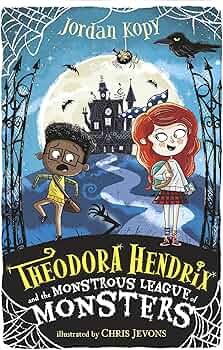“On Writing the Unexpected Narrator”
My debut middle grade novel, Theodora Hendrix and the Monstrous League of Monsters, follows the adventures of one Theodora Hendrix, who isn’t your average ten-year-old: her best friend is a talking, top-hat-wearing tarantula named Sherman. She reads torat cards (think tarot cards, but magical). Oh, and she lives in a haunted mansion full of monsters, breaking Headquarters’ Number One Rule: Keep Monsters Hidden from Humans. When a series of anonymous letters threatens to reveal her secret, Theodora must follow a series of clues to track down the source. If she fails, Theodora will be sent to live with humans (the horror, the horror!) and her family will end up in the Deepest, Darkest Prisons of Transylvania. Forever.
Like many authors, I’m often asked where I got the idea for this book. The story goes like this: my mom and I were watching one of our favorite movies, “My Cousin Vinny”. Fred Gwynne, who played the judge, also played Herman Munster on “The Munsters”, a black and white television show from the 1960s. That fact must have been in my head – probably because my mom mentioned it a dozen-odd times – when I went to sleep, because I woke up the next morning with the idea for a story about a ten-year-old girl being raised by a bumbling family of monster superheroes. I jumped out of bed and grabbed my laptop; two hours later, I had written the book’s opening chapters. Over the next few days, I outlined the plot – at least, I knew where the story started and how it ended, sketched out my ensemble cast of characters, and sorted out the book’s main themes. But what I hadn’t sorted out was my narrator.
Choosing the narrator is one of the most critical decisions an author makes when crafting their story, as this is the vehicle by which your tale is relayed to your reader. There’s much to consider:
For starters, who is the narrator – who’s telling us this story? It can be anyone, really – the main character, a third party, an animal sidekick…When thinking through the various options, considering point of view can be super helpful: most novels typically employ first or third person point of view. In first person, the narrator is directly involved in the story, sharing the events that occurred according to their own recollection or experience, using “I” or “we” to describe the action. A well-known example of this is the Percy Jackson and the Olympians series by Rick Riordan. In third person, the narrator isn’t directly involved in the story, using “he”, “she”, or “they” to describe the action. Third person is often (but not always!) omniscient, meaning that the narrator is all-knowing. A (very!) well-known example of this is the Harry Potter series by J.K. Rowling. Along with point of view, the narrator’s perspective – i.e., their individual perceptions of and interactions with the world at large – should also be considered: a narrator whose perception differs from that of the main character will provide a different experience than one in which a similar worldview is shared. Together, point of view and perception can help to define the best narrator for a given tale; the former tells us the “what”, the latter the “how”.
I had no clear sense of my narrator when I first started writing Theodora Hendrix and the Monstrous League of Monsters. So, I started thinking about perspective and point of view – and kept waffling between the two. I liked the intimacy of first person as it allows readers to experience events with the main character – a technique which is particularly successful with young readers who can, perhaps, more easily envision themselves in that character’s shoes. In contrast, I liked the omniscience of third person as allows the narrator to hint at things yet to come which the main character couldn’t possibly know; this works especially well in novels in which there’s some degree of mystery, which I knew my story would have. In the end, I decided to take a (perhaps not so small) risk and combine the two. The result is a rather unexpected narrator:
In the prologue and the epilogue, my narrator’s point of view is first person. He often breaks the fourth wall, speaking directly to the reader. He’s also mysterious: he declines to introduce himself at the beginning of the tale, stating that his identity is for him to know and “for you to find out”; it is only on the very last page that he finally reveals himself. In contrast, the main body of the novel is largely relayed in deep third person, where the narrator closely mimics Theodora’s perspective. To bridge the gap between the two, he occasionally interrupts the story, breaking the fourth wall to share his own thoughts and insights directly with the reader.
To make this process a little less painful going forward, I’ve made myself a “narrator checklist” which I peruse whenever I begin a new manuscript. Some of the questions I consider are:
- Who is telling this story? Is it one person or multiple people?
- Why are they telling it and not someone else?
- Where do they stand in relation to the story – are they directly involved in the action or observing it from the outside?
- What information do readers need to follow the plot, and who can best convey this to them?
- Comparatively, what information should be withheld or obscured or obscured from readers, allowing for potential misdirection?
Sometimes, choosing a narrator is a matter of trial and error. If the plotting is tight, the characters well-developed, and the pacing appropriate, it may be worth taking another look at your narrator. Changing the point of view and perspective can feel more than a little overwhelming, but it’s worth it in the end: the right narrator can make all the difference.
Published July 16th, 2024 by Simon & Schuster Books for Young Readers
About the Book: If you think monsters don’t exist, just ask Theodora Hendrix. The start of a brilliantly funny new series, perfect for fans of Amelia Fang.
The first rule of the Monstrous League of Monsters is: Keep monsters hidden from humans. But when zombie George and his cat companion Bandit find an abandoned baby, they can’t leave her to be eaten by hobgoblins. So they spirit her home where she quickly becomes part of the family. Fast-forward ten years, and young Theodora doesn’t seem too scarred by her monstrous upbringing. But now a series of anonymous letters suggest that someone is about to reveal their secret. If Theodora doesn’t act fast, she may lose her family for ever…
“Readers will be irresistibly drawn into the captivating world of Kopy‘s monster-filled middle-grade novel, where the promise of tantalizing secrets sets the stage for adventure. …a delightful blend of whimsy and mystery … lively characters and light mystery, the narrator imparts a particularly mischievous charm, with cheeky asides…With playful, comical illustrations reminiscent of the Addams Family that vividly bring the scenes and characters to life, this delightful, cheeky romp is ideal for those who relish eerie tales with a humorous twist.” – Booklist
About the Author: Jordan Kopy is a born and raised New Yorker who now lives in London with her husband and poorly behaved (but lovable) cat. A financial services professional by day (no idea how that happened), Jordan spends her nights with ghouls, witches, and the occasional evil hag. She’s also the author of Theodora Hendrix and the Curious Case of the Cursed Beetle and Theodora Hendrix and the Snare of the Shadowmongers.
Thank you, Jordan, for this post looking at the process of choosing a narrator!



Oh, I love getting sneak peeks into the writing process!! I’ve never even considered writing a chapter book or novel, the process has always seemed too intimidating and overwhelming, but I really enjoy learning about how writers break projects down into meaningful chunks – or don’t, and just let their fingers walk across the keyboard! I’ve never thought that deeply about the importance of choosing the right narrator for a story, so this was really interesting, and shows how much care goes into writing a story – when it’s done right, it just seems so natural!